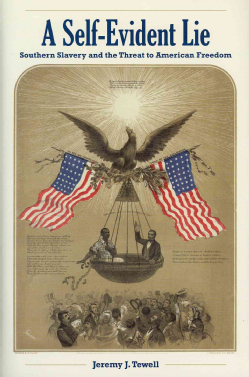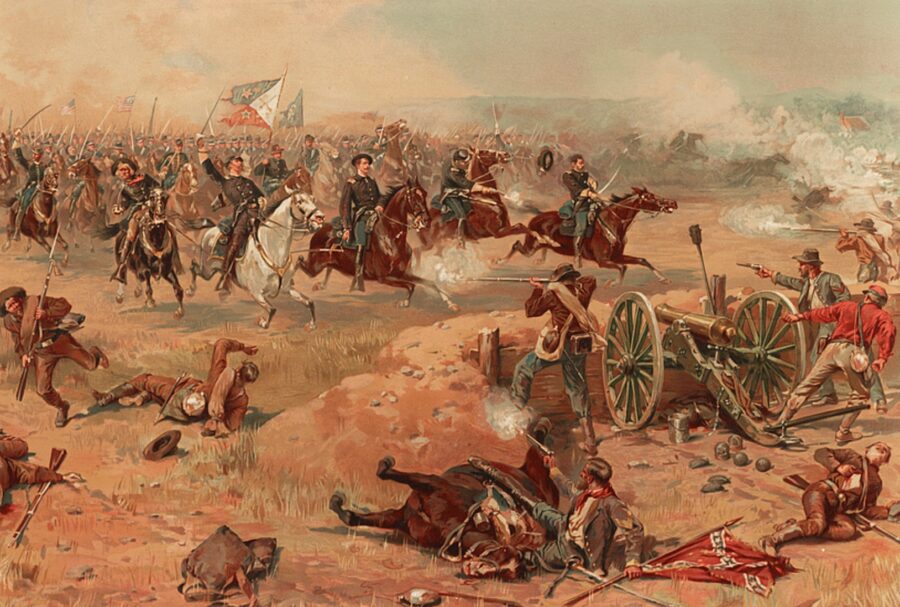A Self-Evident Lie: Southern Slavery and the Threat to American Freedom by Jeremy J. Tewell. Kent State University Press, 2013. Cloth, ISBN: 1606351451. $45.00.
 Ironically, the falsehood discussed in Jeremy J. Tewell’s important study, A Self-Evident Lie: Southern Slavery and the Threat to American Freedom would not be considered a lie today. His title refers to something most Americans consider a self-evident truth: that all men and women are created equal. In this persuasive book, the author examines the extent to which nineteenth-century Americans agreed with the idea that all meant all and, specifically, that this statement included African Americans. This was not merely an esoteric argument about the wording of the Declaration of Independence; instead, this debate went to the heart of the sectional crisis before the Civil War. White northerners felt threatened when southerners defending slavery qualified the “all men” to some men. According to Tewell, northerners believed that “individual liberty, including the liberty of whites, depended on universal liberty” (7); if some men could be slaves, why not all men.
Ironically, the falsehood discussed in Jeremy J. Tewell’s important study, A Self-Evident Lie: Southern Slavery and the Threat to American Freedom would not be considered a lie today. His title refers to something most Americans consider a self-evident truth: that all men and women are created equal. In this persuasive book, the author examines the extent to which nineteenth-century Americans agreed with the idea that all meant all and, specifically, that this statement included African Americans. This was not merely an esoteric argument about the wording of the Declaration of Independence; instead, this debate went to the heart of the sectional crisis before the Civil War. White northerners felt threatened when southerners defending slavery qualified the “all men” to some men. According to Tewell, northerners believed that “individual liberty, including the liberty of whites, depended on universal liberty” (7); if some men could be slaves, why not all men.
Because white northerners were racists and seemed to have no problem with race-based slavery in southern states, scholars have attempted to explain why they came to believe that slavery threatened their own freedom. Eric Foner argued that northerners feared that slave labor undermined free labor; others, have cited fear of the slave power and the outsize role of slave owners in the American political system. While Tewell agrees that these were factors, he argues that slavery and its defenders threatened something more fundamental, the very meaning of the United States’ founding document.
While Tewell discusses the best-known challenge to the universal nature of equality—the Dred Scott decision—it was not just one Supreme Court case that challenged the universality of liberty. Instead, he explains, rejecting universal equality was at the heart of southerners’ defense of slavery. Tewell reviewed the development of southerners’ proslavery arguments that evolved from defending slavery as a necessary evil—we cannot not free slaves—to asserting that it was a positive good—we should not free slaves. While much of this rhetoric rested on racist notions of black inferiority, some proslavery advocates argued that the bottom rung of the laboring class would benefit from enslavement. In response, Lincoln articulated the view that this argument implied that any man, of any race, who was deemed the inferior of another, could be enslaved. Similarly, white northerners viewed reports of slaves who appeared to be white as supporting the notion that slavery was not necessarily about race. White northerners assessed the rhetoric of proslavery advocates, and the reality of white slavery, and wondered if they too could be slaves.
While notions of enslaving poor white laborers might have seemed to be an extreme position held by a few southerners, challenges to the notion of universal liberty were part of mainstream antebellum political rhetoric. It was a democratic Senator from Indiana who asserted that the Declaration of Independence’s declaration of equality was a self-evident lie. In response, Tewell explains, northerners, including Lincoln, created the Republican Party, which argued that narrowing the definition of universal liberty represented a broader threat to northerners’ freedom. Ultimately, it was northerners’ view that individual liberty relied on universal liberty, that explains why northerners, who shared southerners’ racist views, elected Lincoln to the presidency and set the United States on the road to disunion and Civil War.
Tewell has written an enormously thought-provoking book; however, this complex theme may have required the author to pay closer attention to how his book was structured. Organized into a number of thematic chapters, his argument sometimes seems repetitive and confusing. The author’s frequent use of section breaks in lieu of transitions illustrates some of weaknesses of his discussion. Perhaps a more chronological narrative—beginning at the Declaration, through the evolution southerners’ proslavery arguments, to the rhetoric of northern democrats defending slavery’s expansion into new territories, and ending at the rise of the Republican Party and the election of Lincoln—might have been a better way to organize this multifaceted argument. These flaws should not detract from the value of the author’s research and analysis; I was particularly intrigued by the discussion of “white” slaves and how this affected northerners’ fears. A similar sentiment was found in Union soldiers’ letters; meeting slaves with lighter skin coloring affected their view of slavery. Overall, I would recommend this book for its argument, which I believe sheds important light on the coming of the Civil War.
Barbara Gannon is an Assistant Professor of History at the University of Central Florida, the author of The Won Cause (2011), and winner of the 2012 Wiley-Silver Prize for a best first book on the Civil War.
